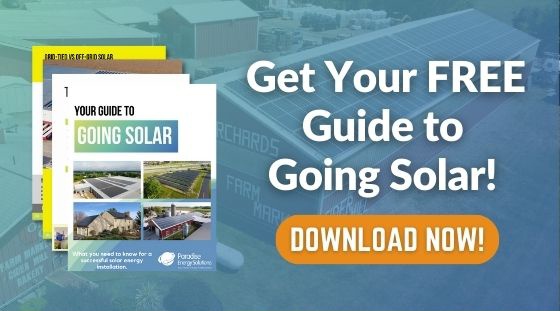How to Choose the Best Solar Panels: Features, Brands, and Performance

A lot hinges on the type of solar panels you choose to install. High-quality panels from a reputable manufacturer can last decades and save you a great deal on electricity costs over the years. On the other hand, panels from manufacturers who prioritize initial cost over long-term performance can leave you with an underperforming system that won’t stand up to the test of time. Learning how to choose the best solar panels is an important step in creating a long-lasting, money-saving solar system. First, you’ll need to narrow down your aesthetic, budgetary, and energy production goals. Then, you can filter through all the options and end up with the perfect solar panels.
We want to help you make the choice that’s right for you and your goals. That’s why we’ve assembled a list of six things you should consider when selecting your solar panels.
How to Choose the Best Solar Panels - Top 6 Considerations
1. Comparing Solar Panel Types - Monocrystalline vs Polycrystalline
There are two main types of solar panels: monocrystalline and polycrystalline. Which one you choose will impact the overall look of your system, its cost, how much electricity it will produce, and how much space your system will cover.
Monocrystalline panels have an overall darker tint to the cells and are typically the more efficient option. Panels with a higher efficiency mean you can produce more electricity with fewer panels, so your overall system takes up less space. However, for all their advantages, monocrystalline panels are often the more expensive option.
Polycrystalline panels have a bluer tint and are typically less efficient than monocrystalline, meaning you’d need a few more panels to generate the same amount of electricity. However, they do often come at a lower price, and despite the additional panels you’ll need, will likely be the cheaper option. For a more in depth breakdown of cost, check out our complete guide about how much solar panels cost.
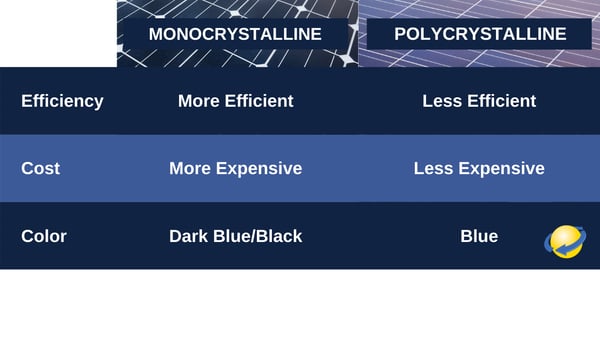 2. Panel Color: The Back Sheet and Frame
2. Panel Color: The Back Sheet and Frame
Another way you can control the look and price of your solar system is through the selection of backsheet and frame color.
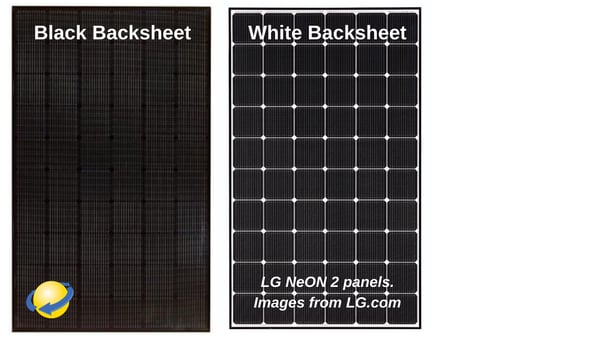
Each panel is composed of several silicon cells that are placed on a back sheet. This back sheet shows through the gaps between the cells and creates a grid-type design. Some manufacturers offer solar panels with black back sheets instead of the typical white.
Black back sheets create a more uniform-looking panel that blends into darker roofs. However, black holds heat, so black back sheets may get hotter than traditional panels, which could slightly reduce the panels’ efficiency.
There are also two options when it comes to the color of the metal frame around the borders of the panels: black and silver. Black frame panels can be more aesthetically appealing but will cost more. Aside from that, both black- and silver-frame panels should perform identically.
3. Determining the Right Solar Panel Size for Your Home or Business
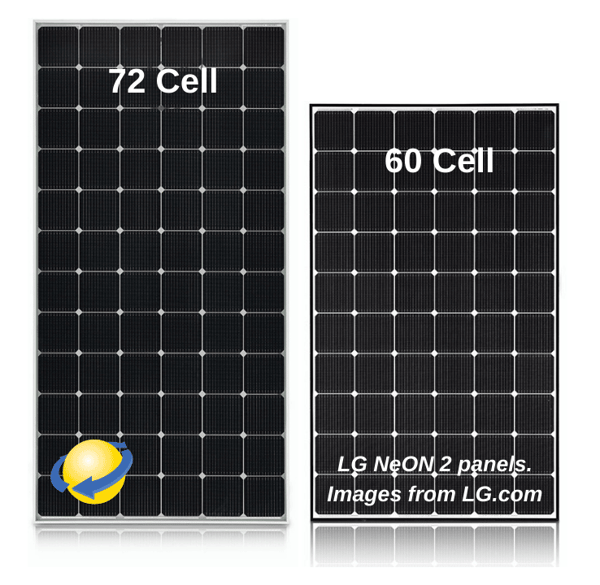
Solar panels come in two different sizes: 60-cell and 72-cell. The size refers to the number of cells (the small, crystalline silicon wafer) on the solar panel. On average, 72-cell panels are about a foot longer than 60-cell panels.
Their larger size makes 72-cell panels better suited for large, wide-open spaces like commercial roofs and ground-mount systems. 60-cell panels are typically better suited to fit in tighter spaces, like on the dormer of a home’s roof. However, this isn’t a hard and fast rule and will vary from location to location.
Overall, 72-cell panels tend to be more economical, as they generate more electricity per panel than an otherwise identical 60-cell panel.
4. Panel Production: Output Rating and Efficiency
Both the panel’s output rating and efficiency will impact how much power it can produce.
The output rating is the three-digit number in the solar panel’s name. It represents how many watts of electricity the panel will generate under ideal conditions.
Most panels have a wattage between 250 watts to 400 watts, with a few panels exceeding the 400-watt mark. A higher wattage means more electricity generated per panel, but it will likely mean a higher price tag. Though you’ll need fewer panels to reach your generation goals, it likely won’t offset the price increase.
However, wattage isn’t the only thing to look for. You should also consider the panel’s efficiency, which is the percentage of electricity it produces from the energy it receives from the sun.
The more efficient a solar panel is, the more kilowatt-hours of electricity it will produce per watt of power capacity. This is especially important if you’re concerned about the amount of space your solar system takes up.
For example, let’s compare two 300-watt solar panels: one that’s 21% efficient and another that’s 17% efficient. Both will produce 300 watts of power under ideal conditions. However, the one that has a higher efficiency will be physically smaller and take up less space than the one that is less efficient. So if you have high electric bills and a small amount of space to install your solar system, you’ll want to look for efficient panels.
5. What Kind of Solar Panel Warranty Will You Be Getting?
An important indication of overall panel quality is a robust warranty from the manufacturer. Many high-quality solar panels are guaranteed for 25 to 30 years and can continue working even after their warranty expires.
Purchasing solar panels that will last is essential to the long-term success of your system. The longer your solar panels generate electricity, the more money you save. Purchasing panels backed by a comprehensive warranty will help guarantee their success.
Most manufacturers offer two kinds of warranties: performance and product warranties. The performance warranty assures that the panel will be capable of producing a specified percentage of power during the warranty period despite degradation. The production warranty protects your panels from material or workmanship issues.
6. Overall Quality and Brand Considerations - What Makes a Good Solar Panel?
You want the highest quality solar panels at the best price. However, there are a few important factors to consider when evaluating the quality of a specific solar panel.
To get a true measure of a solar panel’s quality, you’ll want to look at its guarantee, the manufacturer's reputation, customer reviews, and the panel’s technical specifications for efficiency, temperature coefficient, and power tolerance.
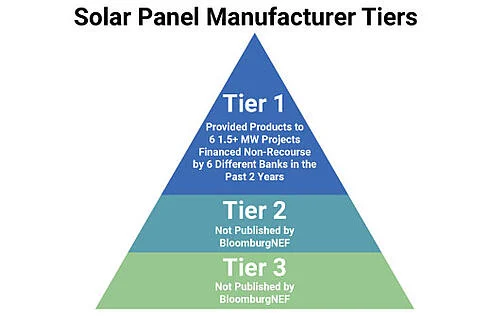
Another way to measure a solar panel brand, though imperfect, is by looking at what “tier” the solar panel manufacturer falls under. When researching different brands, you’ll likely come across lists that separate manufacturers into tier one, and even tier two and three, though there is no formal definition for tiers two and three.
Most assume tier-one solar panel manufacturers tend to be the stronger brands. However, this isn’t necessarily the case. According to Bloomberg New Energy Finance Corporation (BNEF), the tier system for solar panel manufacturers refers to how bankable a solar company is. While it’s fair to reason that a bankable company must have quality products, there are plenty of companies out there that do not meet the tier-one specifications but offer great, high-quality panels.
Overall Quality
Quality is a comprehensive measure that encompasses several aspects of a solar panel, including:
- Efficiency: Higher efficiency panels convert more sunlight into electricity, which is especially important in limited space scenarios.
- Durability: Look for panels that can withstand environmental conditions like high winds, snow loads, and temperature fluctuations. Standards such as IEC 61215 can be indicators of durability.
- Performance in Different Climates: This section addresses how the performance of solar panels can vary in warm climates and the importance of temperature coefficients.
Brand Reputation
The manufacturer's reputation can be a strong indicator of panel quality. Consider the following:
- History and Experience: Brands with a long history in the industry and a track record of innovation and reliability are often preferable.
- Financial Stability: A financially stable company is more likely to honor warranties and be around to service any future claims.
- Customer Reviews and Industry Ratings: Feedback from real users and ratings from industry organizations can provide insight into the brand's reputation and customer satisfaction.
Another way to measure a solar panel brand, though imperfect, is by looking at what “tier” the solar panel manufacturer falls under. When researching different brands, you’ll likely come across lists that separate manufacturers into tier one, and even tier two and three, though there is no formal definition for tiers two and three.
Most assume tier-one solar panel manufacturers tend to be the stronger brands. However, this isn’t necessarily the case. According to Bloomberg New Energy Finance Corporation (BNEF), the tier system for solar panel manufacturers refers to how bankable a solar company is. While it’s fair to reason that a bankable company must have quality products, there are plenty of companies out there that do not meet the tier-one specifications but offer great, high-quality panels.
Choosing the Best Solar Panel for Your Home or Business
While some manufacturers on our list are objectively the “best” in terms of efficiency, warranty, or price, the panels that are right for you will depend on your specific situation.
You should go with the panel that offers the best value, balancing price with performance and quality. It’s about getting a system you’re happy with that’s cost-effective and has the best ROI.
Here are a few factors to consider:
- Assessing Electricity Use: Guide readers on how to assess overall electricity use
- Assessing Roof Characteristics: Roof characteristics are used to choose the optimal solar panel setup.
- Cost vs. Efficiency: Discuss how to balance the cost of solar panels with their efficiency to get the best value for your investment.
What are the Best Solar Panels on the Market in 2025?
There are many solar panel brands, but only a handful have risen to the top for our team at Paradise Energy.
With 16 years of experience installing solar for thousands of customers, we've gained valuable insight and experience with many panel manufacturers. We use that insight to select the brands that we can confidentially offer our customers. Our top three brands are:
Each of these brands was carefully chosen based on specific performance metrics such as customer service, company standing, and product specifications, including performance, aesthetics, warranties, and pricing.
Wrapping Up: Choosing the Best Solar Panels in 2025
There’s no one-size-fits-all answer to which solar panels are the best. That answer changes based on a variety of factors, like your budget, how much electricity you’d like to generate, the space you have to install the system, and what aesthetic concerns you have.
With the sheer amount of options available, this process can be overwhelming. Trying to determine the best combination of panel size, output rating, and efficiency is the most economical for your space, all while ensuring the panels are high quality and backed by extensive warranties takes experience. At Paradise Energy, we’ll maximize your budget and space with panels that suit your specific goals, whether that is budgetary, energy-related, aesthetically driven, or a combination of them all.

